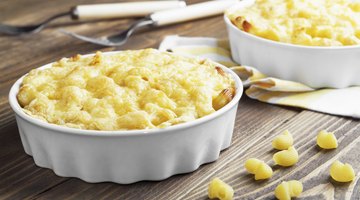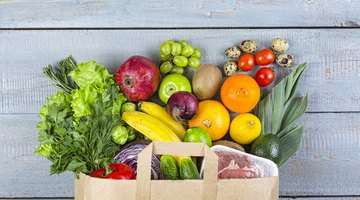What Foods Can a 7-Month-Old Baby Eat and How Much?
Your 7-month-old is already slurping on rice cereals and purees. If you’re wondering what comes next, it depends on his development. While most babies are ready to try a varied menu of smashed and mashed fruits and vegetables, only a few are starting to chew on first finger foods.
Formula and Breastfeeding
Even though your baby is eating solids, that doesn’t mean she’s done with the breast or bottle. You should continue breast or formula-feeding your baby until she is at least 12 months old, according to the American Academy of Pediatrics’ HealthyChildren.org website. Bottle-fed babies can have four to five six to eight ounce bottles per day. Breastfed babies gradually decrease the number of feedings per day as they eat more solids. Between 6 and 12 months, this may dip down to three to four meals of milk, with a few short breast milk snacks added in throughout the day.
Provide Purees
When Can Babies Eat Pasta?
Learn More
By 7 months old, your baby is about one month into eating solid foods. After starting with rice cereal at 6 months, he’s ready to move on to fruit and vegetable purees. He doesn’t have the muscle coordination in his mouth yet to chomp down on highly textured or table foods. You can buy ready-made jarred baby foods. These are fruit and veggie purees can combine two different foods into one jar. These may include apple-blueberry, pear-banana and other similar combinations. Some also include pureed chicken along with apples or another fruit. Continue to introduce thicker purees to help your baby get used to new solid textures.
If you don’t want to go the store-bought route, make similar foods at home. Use a food processor to puree fruits such as peaches, apples or pears. Puree vegetables such as cooked carrots to add in. As your baby grows more accustomed to eating solids and begins to open up to new tastes, puree meats and poultry or tofu to feed him along with fruits and vegetables.
Textures and Finger Foods
As your baby moves towards her 8-month birthday, begin introducing foods with more textures. Before you give her a mash of avocados or consider a mushy finger food such as smashed, well-cooked carrots, look for signs of readiness to move forward. When your baby is able to pick up small objects and bring them to her mouth, she is showing a sign that she’s ready to try out finger foods, notes the AAP.
Only give your 7-month-old foods that don’t pose choking hazards. This includes small, mushy pieces of banana or well-cooked smashed squash. Avoid foods that are chunky, hard, sticky or requiring real chewing. She should still be able to slurp and swallow the foods that you give her at 7 months.
Daily Energy Intake

Breakfast Foods for 9-Month-Old Babies
Learn More
A 7-month-old female needs 608 calories per day and a boy the same age needs 668, according to the U.S. Department of Agriculture’s. Between 7 and 12 months your baby needs 95 grams per day of carbohydrates. These come from breast milk, formula, grains, fruits and vegetables, and supply the energy that your baby needs to grow. Your baby also needs 11 grams of protein a day. Fiber comes from breast milk, formula, yogurt, eggs and meats. Even though fats often get a bad rap, your baby needs them for brain growth. Include 30 grams of good fats from breast, formula, vegetable oils or eggs in your baby’s daily diet.
How Much to Eat
The daily recommended energy and nutrient intakes aren’t exactly easy to calculate when it comes to real portion sizes. Your 7-month-old should eat ¼ to ½ cup of fruits and vegetables each, two to three times per day. For example, he can have ½ cup of applesauce at breakfast, ¼ cup of carrot puree and ½ cup of apples-pears at lunch and ½ cup of mashed avocados and ¼ cup of smashed bananas at dinner. You can also continue to give your baby three to nine tablespoons of cereal at two or three of his feedings. Introduce meats slowly, giving your child roughly 1/8 cup over the course of the day.
This daily diet is in addition to your baby's regular formula or breast milk feedings.
Related Articles
- HealthyChildren.org: Switching To Solid Foods
- BabyCenter: How to Tell How Much Formula Your Baby Needs
- HealthyChildren.org: Working Together: Breastfeeding and Solid Foods
- KidsHealth: Feeding Your 4- to 7-Month-Old
- BabyCenter: Age-by-Age Guide to Feeding Your Baby
- U.S. Department of Agriculture: Nutrition and Feeding
- BabyCenter: Baby Food Basics









